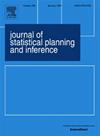M-procedures robust to structural changes detection under strong mixing heavy-tailed time series models
IF 0.8
4区 数学
Q3 STATISTICS & PROBABILITY
引用次数: 0
Abstract
Many tests of change points resort to least squares estimation method, but it can lead to bias if these observations are heavy-tailed processes. The aim of this paper is to construct a ratio-typed test based on M-estimation, which avoids the long-range variance estimation and is robust to structural change detection under strong mixing series with heavy-tailed. The proposed test consisting of M-procedures has more utility in that it allows processes in the domain of attraction of a stable law with index , not limited to . Under some regular conditions, asymptotic distribution under the null hypothesis of no change is functional of a Brownian motion, and the divergent rate under the alternative hypothesis is also provided. Furthermore, the convergence rate of a ratio-typed change point estimator is established. Simulation study illustrates there is no distortion in empirical sizes, and empirical powers have satisfactory performance. Finally, two practical applications to real examples are presented as well.
在强混合重尾时间序列模型下,m程序对结构变化检测具有鲁棒性
许多变化点的测试采用最小二乘估计方法,但如果这些观察是重尾过程,则可能导致偏差。本文的目的是构建一个基于m估计的比率型检验,该检验避免了长时间方差估计,并且对重尾强混合序列下的结构变化检测具有鲁棒性。所提出的由m -过程组成的检验具有更大的实用性,因为它允许在索引κ∈(0,2)的稳定定律的吸引域内的过程,而不限于(1,2)。在一定的正则条件下,无变化零假设下的渐近分布是布朗运动的泛函,并给出了备择假设下的发散率。进一步给出了比值型变点估计量的收敛速率。仿真研究表明,经验大小没有失真,经验幂具有令人满意的性能。最后,给出了两个实例的实际应用。
本文章由计算机程序翻译,如有差异,请以英文原文为准。
求助全文
约1分钟内获得全文
求助全文
来源期刊
CiteScore
2.10
自引率
11.10%
发文量
78
审稿时长
3-6 weeks
期刊介绍:
The Journal of Statistical Planning and Inference offers itself as a multifaceted and all-inclusive bridge between classical aspects of statistics and probability, and the emerging interdisciplinary aspects that have a potential of revolutionizing the subject. While we maintain our traditional strength in statistical inference, design, classical probability, and large sample methods, we also have a far more inclusive and broadened scope to keep up with the new problems that confront us as statisticians, mathematicians, and scientists.
We publish high quality articles in all branches of statistics, probability, discrete mathematics, machine learning, and bioinformatics. We also especially welcome well written and up to date review articles on fundamental themes of statistics, probability, machine learning, and general biostatistics. Thoughtful letters to the editors, interesting problems in need of a solution, and short notes carrying an element of elegance or beauty are equally welcome.

 求助内容:
求助内容: 应助结果提醒方式:
应助结果提醒方式:


